Physical Address
304 North Cardinal St.
Dorchester Center, MA 02124
The adrenal gland is a bipartite endocrine gland composed of cortex and medulla, each of which has different embryogenesis, structure, and function. The adrenal cortex arises from cells associated with the coelomic epithelium, which are of mesodermal origin. The cortex plays a vital role in the regulation of water and electrolyte balance, mainly by the secretion of mineralocorticoids and, through the action of glucocorticoids, it mediates changes in intermediary metabolism, wound healing, growth, and inflammation and also influences some aspects of the immune system. The cortex is also a source of sex steroids. The medulla is of neural crest origin and secretes catecholamines, mainly epinephrine, which mediates rapid adaptations to stress and changes in the environment. In adults the right adrenal gland is roughly pyramidal in shape and the left is more elongate or crescentic. The individual or combined adrenal weight depends on various factors such as age, presence and chronicity of a variety of diseases and, most important, the effort made to carefully remove adherent connective tissue and fat before weighing the specimen. In the newborn adrenal gland a rather marked decrease in weight occurs in the first few weeks of life because of regression of the fetal (or provisional) cortex. In one study the average combined weight of adrenal glands from full-term newborns was between 6 and 7 g and in the age interval 9 to 14 weeks it had decreased to about 2 g. In adults the average weight of individual glands obtained surgically is about 4 g (1 standard deviation = 0.80 g), and the adrenal medulla accounts for approximately 10% of the weight of the entire gland.
The normal adrenal cortex in adults is almost 2 mm thick and histologically often shows distinct zonation. The zona glomerulosa is a thin, usually discontinuous layer beneath the capsule and comprises 5% to 10% of the cortex in some areas of the gland. The zona fasciculata constitutes about 70% of the thickness of the cortex and is normally composed of radial columns or cords of cells with lipid-rich, pale-staining cytoplasm. The remainder of the cortex is composed of the inner zona reticularis; the cells here usually have compact eosinophilic cytoplasm and there may be prominent lipochrome pigment. The adrenal medulla is composed of chromaffin cells concentrated in the head and body of the gland, with cells arranged in discrete nests or short anastomosing cords. The anatomy of the adrenal vasculature is also distinctive, with tributaries of the central adrenal vein having a dysmorphic array of medial smooth muscle, sometimes allowing very close juxtaposition of cortical or chromaffin cells with the vascular space. Occasionally one may see a small intrusion of cortical or chromaffin cells into the vascular lumen covered by a delicate layer of endothelium. There is quite a recent detailed account of normal adrenal cortex zonation and factors which regulate its morphogenesis during fetal life; structure and function of adrenal cortex in the adult is also addressed.
One or more adrenal cortical nodules can be encountered in patients without clinical or laboratory evidence of hypercorticalism ( Fig. 19.1 ). The incidence of cortical nodules increases with age and is associated with hypertension and diabetes mellitus. Nodular enlargement of the adrenal gland(s) may be detected as an incidental finding using high-resolution abdominal computed tomography (CT) scan and may be mistaken for a true neoplasm. Most of these incidentalomas have been referred to as adenomas. Some nodules have been shown to take up a radionuclide precursor in steroid biosynthesis and are hence nonhyperfunctional rather than nonfunctional. Based on immunohistochemical analysis of steroidogenic enzymes, most small, nonfunctioning adrenal cortical adenomas (incidentally discovered in asymptomatic patients) have the capacity to produce biologically active steroids, including cortisol. Preclinical or subclinical Cushing syndrome is reported in some patients who have subtle evidence of hypercortisolism with diagnosis confirmed by basal and dynamic endocrine testing; there may be no obvious evidence of clinical signs and symptoms of excess cortisol secretion. A potential complication of adrenalectomy in the unrecognized setting of mild hypercortisolism is adrenal cortical insufficiency. The prevalence of subclinical Cushing syndrome may be higher than previously reported, and treatment decisions can be a challenge in the clinical management of this mild hypercortisolism.
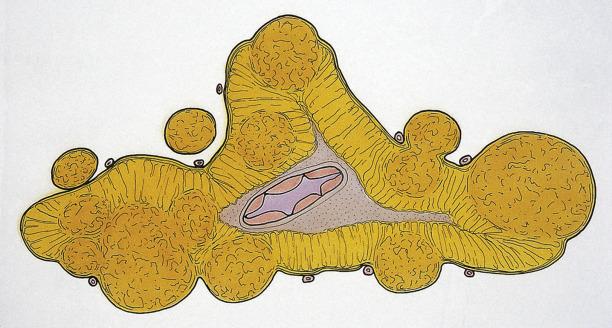
In pituitary-dependent Cushing syndrome (Cushing disease), as well as in ectopic adrenocorticotropic hormone (ACTH) syndrome, the adrenal glands may show small areas of vague nodularity, usually only a few millimeters in size. In some cases of Cushing disease, the adrenal glands may become markedly hyperplastic with macronodules, which may reflect a late stage of diffuse and micronodular hyperplasia or, in rare instances, may represent a seemingly autonomous adrenal cortical hyperplasia that may simulate a neoplasm.
Much has been written with regard to the diagnosis and management of AIs. In 2002 the National Institutes of Health (NIH) held a consensus conference to determine the best approach to managing these incidentally discovered lesions. By definition, AIs are clinically inapparent adrenal masses discovered inadvertently during diagnostic testing or treatment for other clinical conditions not related to suspicion of adrenal disease. This definition excludes patients undergoing imaging procedures and diagnostic evaluation as part of staging and workup for cancer. A summary of autopsy studies shows a prevalence of adrenal nodules at about 6%, but with a wide range reported (1% to about 30%). AIs are detected in about 5% of abdominal CT scans and the prevalence may increase with age. The recommendations that came out of the NIH conference are highlighted in Box 19.1 . Most AIs (approximately 80%) turn out to be benign, nonfunctioning cortical nodules or adenomas. Cushing syndrome is estimated to be present in 4% to 5% of patients with AIs, but it may be higher if cases of subclinical Cushing syndrome or mild hypercortisolism are included. About 3% to 6% of AIs are pheochromocytomas. Since the original consensus statement, other reviews have appeared. Diagnostic imaging of the adrenal gland has improved significantly the ability to characterize many adrenal tumors and tumorlike lesions, including AIs preoperatively. In 2009 the American Association of Clinical Endocrinologists and the American Association of Endocrine Surgeons issued medical guidelines for the management of adrenal incidentalomas. A simplified algorithm from these guidelines is shown in Fig. 19.2 . Tumor size appears to be a significant predictor of the likelihood of malignancy. A study showed that the likelihood of malignancy doubles to 10% with tumors 4 cm or larger and there is a more than ninefold increase in the likelihood of malignancy in tumors 8 cm or larger.
All patients with an incidentaloma should have a 1-mg dexamethasone suppression test and measurement of plasma-free metanephrines.
Patients with hypertension should also undergo measurement of serum potassium and plasma aldosterone concentration to plasma renin activity ratio.
A homogenous mass with a low attenuation value (<10 HU) on computed tomography is probably a benign adenoma.
Surgery should be considered in all patients with functional adrenal cortical tumors that are clinically apparent.
All patients with biochemical evidence of pheochromocytoma should undergo surgery.
Data are insufficient to indicate the superiority of a surgical or nonsurgical approach to manage patients with subclinical hyperfunctioning adrenal cortical adenomas.
Recommendations for surgery based on tumor size are derived from studies not standardized for inclusion criteria, length of follow-up, or methods of estimating the risk for carcinoma. Nevertheless, patients with tumors >6 cm usually are treated surgically, and those with tumors <4 cm are generally monitored. In patients with tumors between 4 and 6 cm, criteria in addition to size should be considered in the decision to monitor or proceed to adrenalectomy.
The literature on adrenal incidentaloma has proliferated in the last several years. Unfortunately, the lack of controlled studies makes formulating diagnostic and treatment strategies difficult. Because of the complexity of the problem, the management of patients with adrenal incidentalomas will be optimized by a multidisciplinary team approach involving physicians with expertise in endocrinology, radiology, surgery, and pathology. The paucity of evidence-based data highlights the need for well-designed prospective studies.
Open or laparoscopic adrenalectomy is an acceptable procedure for resection of an adrenal mass. The procedure choice will depend on the likelihood of an invasive adrenal cortical carcinoma, technical issues, and the experience of the surgical team.
In patients with tumors that remain stable on two imaging studies done at least 6 months apart and do not exhibit hormonal hypersecretion over 4 years, further follow-up may not be warranted.
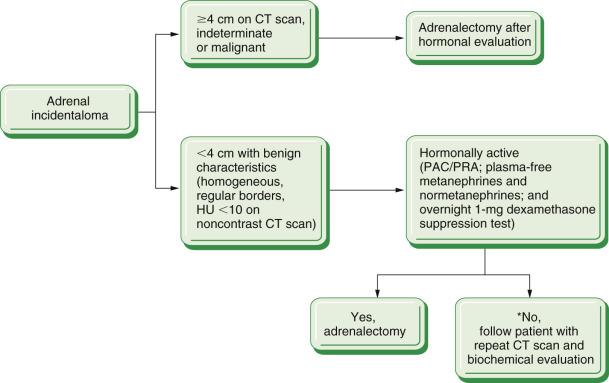
In general, the majority of ACAs occur in adults, with a slight predilection for females. ACAs in children are rare and most often associated with virilization. The true incidence of ACA is unknown because most are diagnosed during life only if associated with hormone secretion. Those ACAs detected other than by chance are associated with excess secretion of usually one class of steroid hormones. On rare occasion an adrenal cortical neoplasm or nodule occurs in extraadrenal sites, such as within the spinal canal or within the spinal cord.
The various causes of Cushing syndrome are shown in Table 19.1 . Seventy to 80% of cases are ACTH dependent with Cushing disease being most common. Twenty to 30% are ACTH independent and are usually due to ACA (10%–20%), followed by adrenal cortical carcinoma (ACC) (5%–7%). ACA has also been reported as the fourth component of the Carney triad (gastric stromal tumor, pulmonary chondroma, and extraadrenal paraganglioma). The pathologist also needs to be aware of bilateral adrenal cortical hyperplasia (macronodular hyperplasia with marked adrenal enlargement [MHMAE]) and primary pigmented nodular adrenocortical disease (PPNAD) since both of these rare disorders are usually treated by bilateral adrenalectomy. In the case of MHMAE it may be mistaken for a unilateral or bilateral cortical neoplasm with overt or mild (subclinical) hypercortisolism. The genetic basis for a significant number of cases of MHMAE has been reported to be germline mutations in ARMC5 (armadillo repeat containing 5). MHMAE may be a complex heterogeneous disorder associated with various genetic defects. Some patients have been reported to have aberrant expression of ACTH within the hyperplastic adrenal cortical tissue suggesting that not all cases of MHMAE are actually ACTH independent. PPNAD is an important component of the rare dominantly inherited disorder known as the Carney complex. The adrenal glands may be small, normal in size or mildly enlarged, and contain multiple small black or brown cortical nodules usually up to 4 mm in size. Examination of transverse sections through the glands may show atrophy of the internodular cortex. A recent study from the Mayo Clinic reviewed 37 patients with Carney complex 17 of whom had classic Cushing syndrome due to PPNAD. Cushing syndrome is a rare feature of McCune-Albright syndrome (see Table 19.1 ) and is usually due to ACTH-independent primary bilateral adrenal disease interpreted as nodular adrenal cortical hyperplasia; ACA is rarely seen.
| Proportion or % | |
|---|---|
| ACTH Dependent | 70%–80% |
| Cushing Disease | 60%–70% |
|
60%–70% |
|
Rare |
| Ectopic ACTH | 5%–10% |
|
About 4% |
|
About 6% |
|
About 2% |
| Ectopic CRH | Rare |
| ACTH Independent | 20%–30% |
|
10%–20% |
|
5%–7% |
|
1%–2% |
|
<2% |
|
<2% |
|
* Polyostotic dysplasia, café au lait cutaneous spots, and precocious puberty.
ACAs found in Cushing syndrome usually weigh less than 50 g and on cross section are often well defined with apparent encapsulation ( Fig. 19.3 ); occasional tumors weigh over 100 g. The cut surface may appear bright yellow or golden yellow throughout or have irregular mottled areas of dark pigmentation. Occasionally areas of hemorrhage may be seen, but confluent tumor necrosis is very unusual. Careful inspection of the attached adrenal cortex or the contralateral gland may show cortical atrophy. Microscopically the tumor often has a relatively smooth, pushing border with a pseudocapsule resulting from compression of adjacent tissue or expansion of the adrenal capsule. Tumor cells have pale-staining, lipid-rich cytoplasm similar to cells of the zona fasciculata ( Fig. 19.4A and B ). In well-preserved and well-fixed specimens, the lipid-rich cytoplasm has a finely vesicular appearance. Abundant intracytoplasmic neutral lipid may be demonstrated ( Fig. 19.5 ). Some tumor cells may be admixed with cells that have more compact eosinophilic cytoplasm resembling the zona reticularis ( Fig. 19.6 ); some cells may contain prominent lipochrome pigment. Architectural patterns commonly seen are trabecular (or short cords) and alveolar with rounded nests of cells. Nuclei are usually vesicular with small dotlike nucleoli; occasionally nuclei are small and pyknotic or may be enlarged and pleomorphic. Areas of lipomatous or myelolipomatous metaplasia may be present ( Fig. 19.7 ). Ultrastructurally the cells contain abundant lipid and have mitochondria with tubular or vesicular cristae along with prominent smooth endoplasmic reticulum ( Fig. 19.8 ).
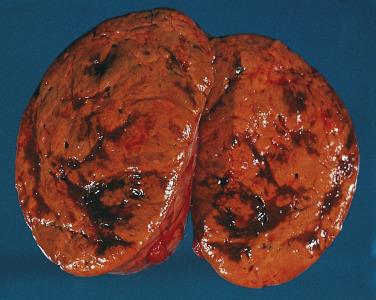

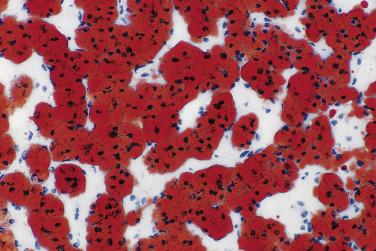
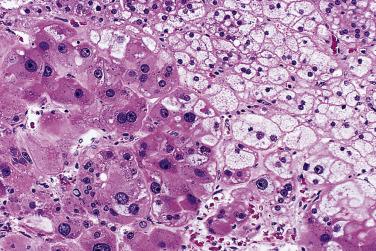
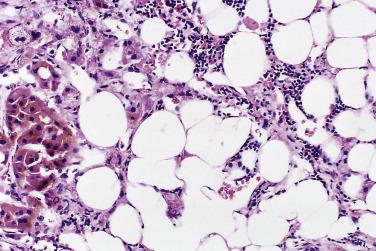
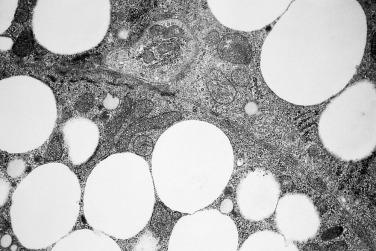
The various causes of PH are listed in Box 19.2 . The most common cause of PH is idiopathic bilateral hyperplasia which typically is not treated surgically. ACA accounts for about 30% to 35% of primary PH cases, while less than 1% are due to ACC or familial hyperaldosteronism (FH) types 1, 2, and 3. It is the patient with unilateral tumor who should undergo surgical resection, which has been shown to ameliorate hypertension in 50% to 60% of cases. Results of surgical versus medical management and treatment outcomes are provided in a recent review.
Idiopathic bilateral hyperplasia (60%–70% of PH cases)
Aldosterone-producing adenoma (30%–35% of PH cases)
Familial hyperaldosteronism (FH) (1% of PH cases)
FH type 1 (glucocorticoid remediable)
FH type 2 (linked to chromosome 7p22 mutation)
FH type 3 (linked to KCNJ5 potassium channel mutation)
Adrenal cortical carcinoma (<1% of PH cases)
The ACAs in primary hyperaldosteronism (aldosteronomas) are often small and solitary, with most being less than 2 to 3 cm in diameter. In 1% to 6% of cases the tumor is bilateral or multiple. An occasional tumor is quite large, weighing up to 75 g or more. The small size of some tumors may make detection difficult in the intact gland, but transverse sectioning reveals a tumor that is round to ovoid and often bright yellow (or canary yellow) ( Fig. 19.9 ). Some larger tumors may show degenerative change with hemorrhage.

Histologically tumor cells have an alveolar or nesting pattern or are arranged in short cords or trabeculae ( Fig. 19.10 ). Four morphologic variants of the tumor cell have been described. Pale, lipid-rich cells resembling the zona fasciculata are most common ( Fig. 19.11 ); other cells have a higher nucleus to cytoplasm ratio with pale cytoplasm, resembling cells of the zona glomerulosa or more compact eosinophilic cytoplasm similar to the zona reticularis. Hybrid cells also have been described with features intermediate between zona glomerulosa type and zona reticularis type cells. The attached or contralateral adrenal cortex may show hyperplasia of the zona glomerulosa ( Fig. 19.12 ). Spironolactone bodies may be seen in patients treated with this aldosterone antagonist ; these inclusions are more frequent in the nonneoplastic zona glomerulosa, although they have been described within tumor cells. The inclusions may be as large as the nucleus and appear as eosinophilic and scroll-like with a surrounding clear halo ( Fig. 19.13 ).
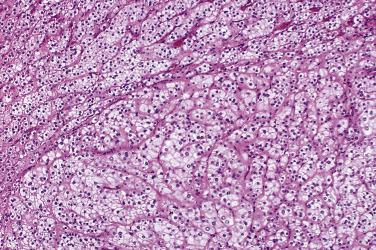
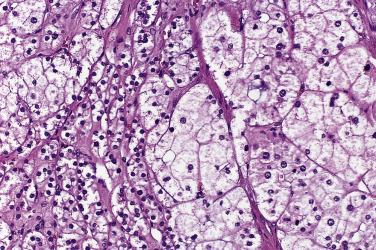
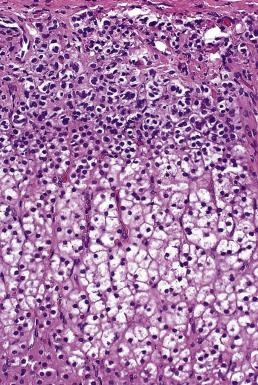
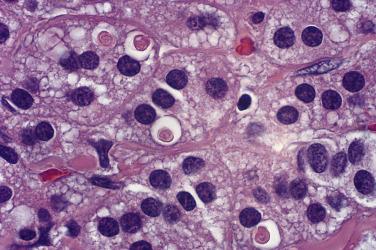
Become a Clinical Tree membership for Full access and enjoy Unlimited articles
If you are a member. Log in here